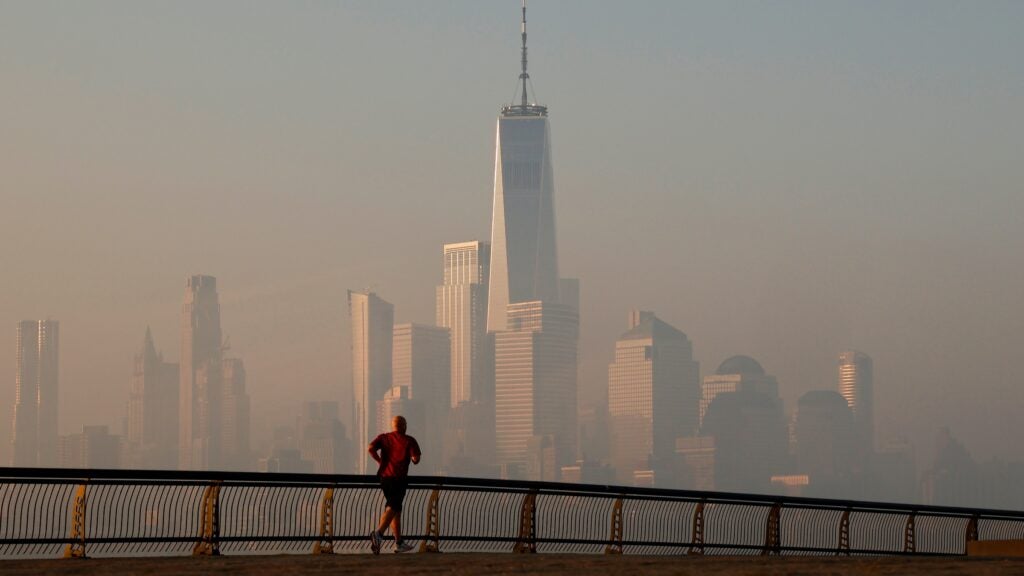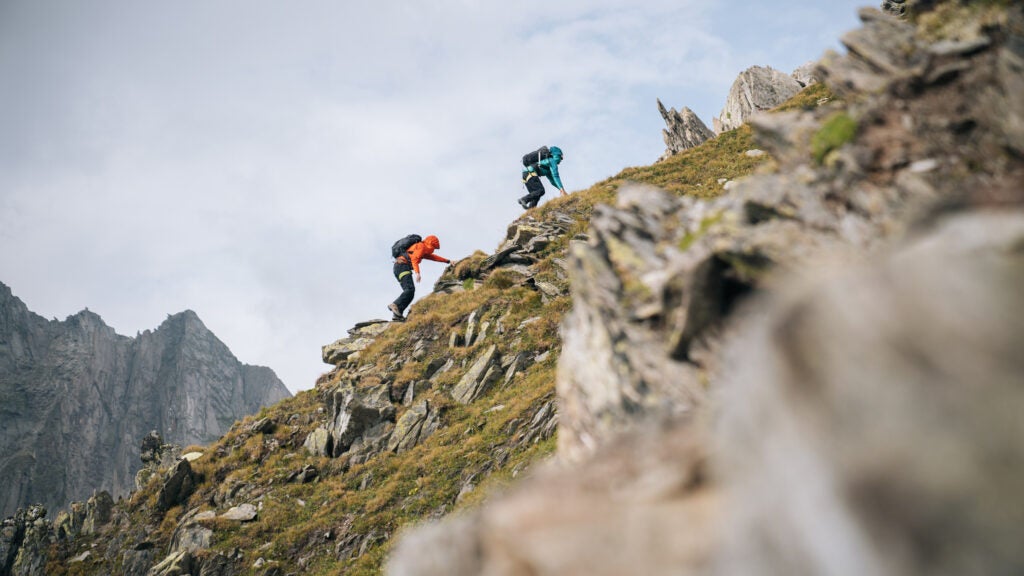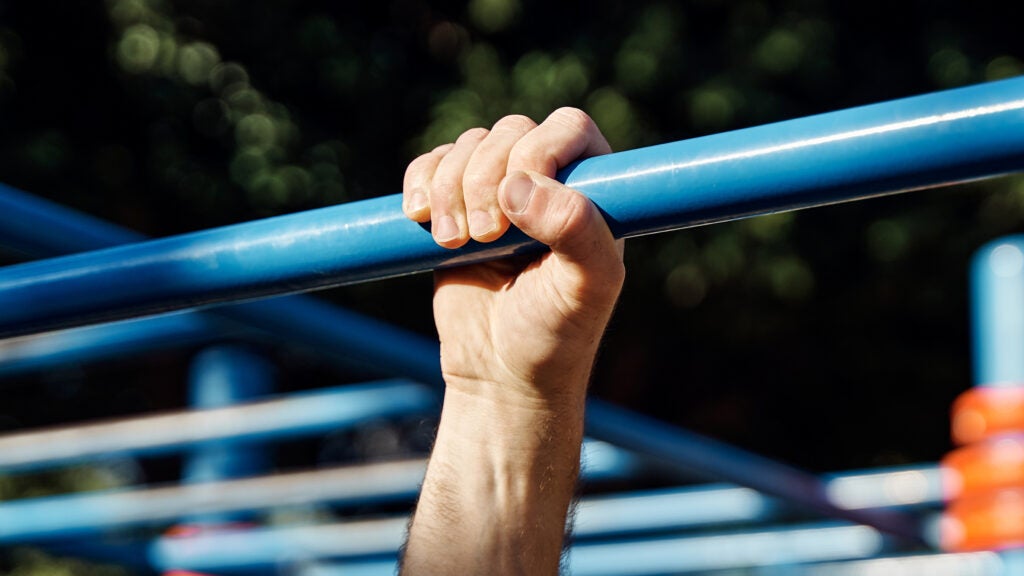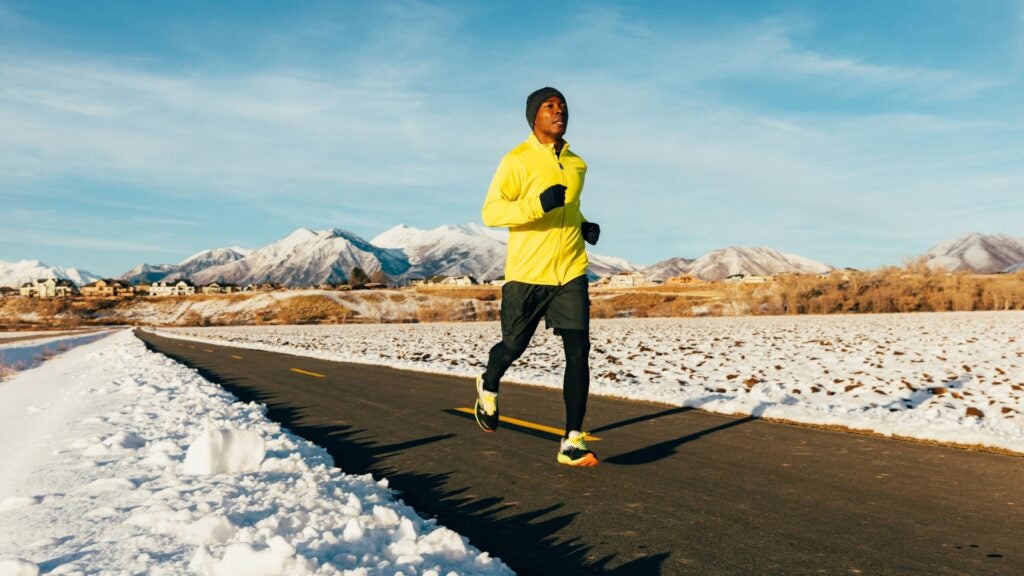One of the funny little details in Eliud Kipchoge’s attempts to run a sub-two-hour-marathon was the electric pace cars. In Nike’s Breaking2 race in 2017, they used a Tesla. In the INEOS 1:59 Challenge, where Kipchoge actually broke the barrier, it was an Audi e-tron equipped with a specially built cruise control that was accurate to within less than a meter over the entire marathon distance. “There will be no emissions out of the back to upset any of the runners,” one of the INEOS engineers boasted before the race.
Was this just window-dressing, like the strips of aerodynamic tape that the Breaking2 runners pasted to their calves? Or does a bit of exhaust in the air actually slow you down? A few studies over the years have attempted to answer this question, but the results have been unclear, in part because it’s difficult to get accurate readings of air quality on the racecourse itself. But a new study from a research team at Brown University, led by Elvira Fleury and Joseph Braun, offers a more definitive answer: it matters.
The Problem with Particulate Matter
Fleury and Braun used a “spatiotemporal machine learning model” to produce detailed hyperlocal estimates of exactly how much fine particulate matter was in the air at each mile marker along the courses of nine major marathons in the U.S. for each year between 2003 and 2019. The model integrates readings from nearby air sensors with satellite data, weather, topography, and other inputs.
Fine particulate matter—also known as PM2.5 or, more familiarly, soot—refers to particles that are less than 2.5 microns in diameter, and is produced by internal combustion engines, forest fires, and other sources. It’s easy to inhale, and can cross from your lungs into your bloodstream, triggering inflammation and oxidative damage that raises the risk of heart disease, diabetes, and other conditions. When you’re running, you breathe more air than usual, and suck it in through your mouth, which bypasses the nasal filtration (i.e. hairs) that would otherwise catch some of the particles. This triggers a variety of problems, including constricting the blood vessels that supply your muscles with oxygen—bad news for a marathoner.
The machine learning model showed that PM2.5 levels varied widely from place to place and year to year. Levels in Boston and Chicago were as high as 20 micrograms per cubic meter in some years, and as low as 2 or 3 micrograms per cubic meter in others. Other courses like New York, Houston, and Los Angeles were in a similar range. The study, which appears in the journal Sports Medicine, combined this pollution data with 2.5 million finishing times, adjusting for other factors like heat and humidity.
How Does Air Pollution Affect Marathoners?
Before digging into the results, it’s worth pausing to consider what we’d expect to see. On a superficial level, there are two big trends to consider. The obvious one is that slower runners are out there longer, so we’d expect the total amount of time lost to increase with finishing time. The other one is that faster runners tend to breathe more heavily, so they suck in more particles per breath and lodge them more deeply in their respiratory systems—so we might, conversely, expect the effects to decrease with finishing time.
The most important question, though, is whether there are any effects at all. Overall, male marathoners at a given percentile finishing position were 32 seconds slower for each increase of 1 microgram per cubic meter in PM2.5 levels; female marathoners were 25 seconds slower. That may sound like a modest effect, but it seemingly suggests that average Chicago Marathon times in a low-pollution year like 2019 (~3 micrograms per cubic meter), might be around eight minutes faster than in a high-pollution year like 2011 (~20 micrograms per cubic meter). Even if that turns out to be an overestimate—I’ve taken the most extreme comparison I could find—it suggests that we’re talking about minutes rather than milliseconds.
Here’s how the effect varied depending on finishing position. The graphs below show finishing percentile on the horizontal axis, with first place on the left and last place on the right. The change in finishing time per microgram per cubic meter of PM2.5 is on the vertical axis. Graph A shows male finishers, graph B shows female finishers.
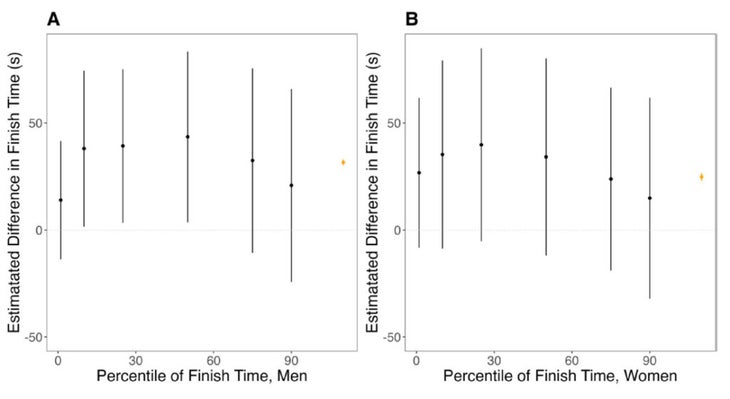
In both cases, the pattern is roughly the same. The fastest finishers have a relatively small effect; the median (which for most of the races tends to be between 4:00 and 5:00) and slightly-faster-than-median finishers have the biggest effect; and the slowest finishers have a smaller effect.
What explains this curve? It’s hard to know. It could be competition between the two factors I mentioned above: shorter exposure time protects the faster finishers, less heavy breathing protects the slower finishers, but runners in the middle get hammered. There are also lots of other possibilities. Maybe more well-trained runners are less affected by breathing discomfort. Maybe the anti-inflammatory effects of high aerobic fitness confer some protection from the negative effects of pollution. Maybe you actually adapt to polluted air if you train in it enough. There are glimmers of evidence for all these effects, but they remain speculative.
What These Air Pollution Findings Mean in Practice
The idea that air pollution hurts athletic performance certainly isn’t new—recall the furor when U.S. athletes wore breathing masks to protect their lungs with they arrived in Beijing for the 2008 Olympics. What’s different here is that the effects are showing up even at very modest levels of air pollution. The current EPA safety standard for 24-hour exposure to PM2.5 is 35 micrograms per cubic meter, well above the levels seen in any of the races. The full-year standard was lowered last year from 12 to 9 micrograms per cubic meter. Of all the race-years analyzed, 61 percent of them were below this more rigid 9 micrograms per cubic meter standard—and yet these pollution levels still impacted race times.
One takeaway, then, is that if you’re going for a big marathon PR and you have a private pace car guiding you, it might be worth going electric. More generally, add air quality to the long list of factors to consider in choosing a race or evaluating a performance after the fact. If you set your PR at Boston in 2004, or Chicago in 2011, or Philadelphia pretty much any year before 2015, your coulda-shoulda-woulda time just got a few minutes faster.
For more Sweat Science, join me on Threads and Facebook, sign up for the email newsletter, and check out my forthcoming book The Explorer’s Gene: Why We Seek Big Challenges, New Flavors, and the Blank Spots on the Map.
Source link

